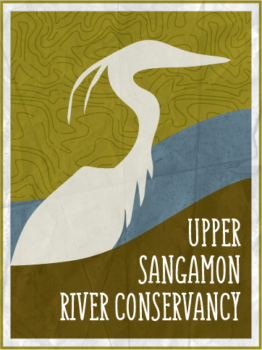“The genius that defines men and spots of earth, and chooses them for memory has laid its hand upon the Sangamon River . . . .” Edgar Lee Masters, The Sangamon
Masters’ book was part of the Rivers of America series, originally published in the 1940s (Prairie State Books edition, U. of I Press, 1988). Masters’ focus is almost exclusively on the lower portion of the river–the “Sangamo Country” from Springfield through Menard County to the Illinois River–which was his youthful home, full of colorful history and Lincoln Lore. Masters does give his readers some broader insights into the river’s history.
[French Jesuit Pierre] Charlevoix “called the Sangamon the Sa-qui-mont. The Indian word was probably ‘Sau-kie-min,’ from ‘auki,’ earth, and ‘min,’ good. Another derivation is said to be from ‘Saukie,” the name of an Indian triabe, and ‘ong’ meaning a place; in other words, a river of the Sauks. Another derivation is ‘sa-gie,’ meaning a lake, and ‘mong,’ meaning a loon.” (8-9)
Near the end of his work, Masters offer this poetic vignette of the river: “The Sangamon River! Not navigable, not noted for its commercial activity, not distinguished for majestic scenery, or for a battle, nor for a single historic event, distinguished for nothing but good and useful lives lived along its shores, and for the beauty of its prairies that sleep and bloom and wave their grasses to the passing winds.” (235)
This section of our website will explore the natural and cultural history of the upper Sangamon, gleaned from local histories and accounts. While some local lore (and personal experience!) might challenge Masters’ perspective on the rivers’ “lack of distinction,” those “good and useful lives” it has nurtured through the years are a testimony to its enduring influence in this region.
The upper Sangamon, particularly between Mahomet and Monticello, runs along the face of a terminal moraine within the Lake Michigan Glacial Lobe, which ranges in age from 28,000 to 12,000 BP. During the glacial Woodfordian Substage (middle Wisconsin Stage), ice of the Lake Michigan Glacial Lobe advanced rapidly, leaving a terminal moraine parallel to the modern Sangamon River.[2] The ice stagnated and melted behind this moraine, without the meltwater overtopping the terminal moraine. Along this stretch, the eastern part of the watershed of the Sangamon therefore consists of short creeks, two to three miles (3–5 km) in length, that drain the face of the moraine. This forms an asymmetric watershed typical of rivers formed along the face of a terminal moraine.
The river was home to many different groups of Native Americans in the centuries before the arrival of Europeans. The name of the river comes from a Pottawatomie word Sain-guee-mon (pronounced “sang gä mun”) meaning “where there is plenty to eat.” In the 18th century, groups of the Kickapoo settled along the river. In the middle 18th century, the region near the river was the scene of a conflict between the Illini and Fox as part of the larger French and Iroquois Wars. French traders were active in the region throughout the middle 18th century when it was part of the Illinois Country (source: Wikipedia).
In contrast with Masters’ assertion that the river lacks distinction in battle, there are, as in many places, tales of Indian wars. Richard L. Morgan, in Cornsilk and Chaff of Champaign County (Sesquicentennial Committee of Champaign County, 1969), elaborates: “According to a legend, the Potawatomi challenged the Kickapoo for hunting rights on the Sangamon. The Battlefield was the so-called ‘Bloody Bend,’ just south of Mahomet. This locality appears as ‘North Bend’ on maps of 1845-54 vintage.” (5)
Isabelle Purnell’s popular work, An Unofficial History of Mahomet, Illinois (Mayhaven, 2000), offers this vignette of the river:
“There were never large boats on the Sangamon, but the river and the timber offered an area of protection which [early settlers] did not have on the prairie and . . . wood for the building of their cabins and for fuel. They also made their furniture, cooking utensils, fences and many other things from the Sangamon timber. There was also much fishing, hunting and trapping of animals along the Sangamon. In the winter, ice was cut from the river, to be stored for summer use. There were taverns on both the east side and the west side of the river. The river also served as a recreational area [for] swimming and camping . . . .” (16)
A chronology of early events along the river in the Mahomet area (again, courtesy of Purnell)–
1832 Daniel Porter platted a town of 38 lots named Middletown (halfway btw. Danville & Bloomington). The site was near a ford across the river along a trail called Old Bloomington Rd.
1836 County Commissioners collected a $5.00 tavern bond from Daniel Porter and a $2.00 ferry fee from William Osborne. Ferry rates were set at six ¼ cents for men, cows, horses; 25 cents for horse and wagon; three cents for pigs and sheep.
1850 The river had been dammed for a grist mill with logs which washed out in Spring flooding and had to be replaced.
1851 Samuel Dean and David Carter now operated the ferry at reduced rates—five cents for men, horses, oxen; 15 cents for horse and wagon; two cents for pigs and sheep.
(to be continued . . . )


